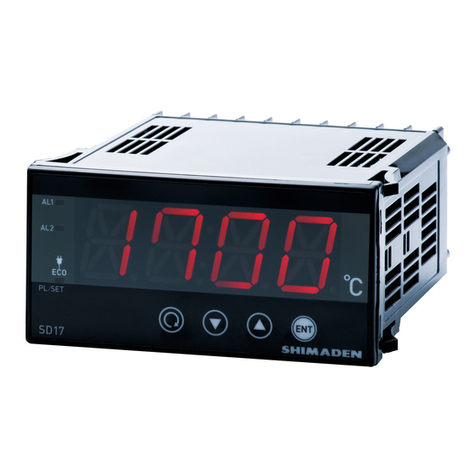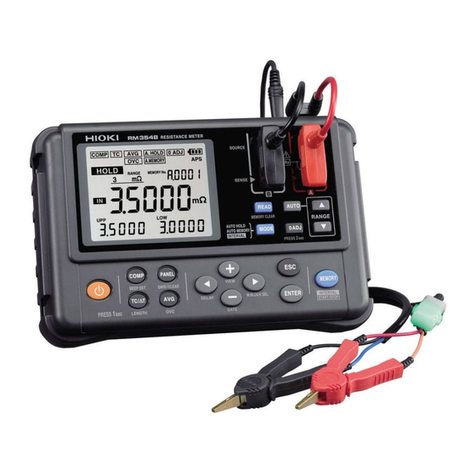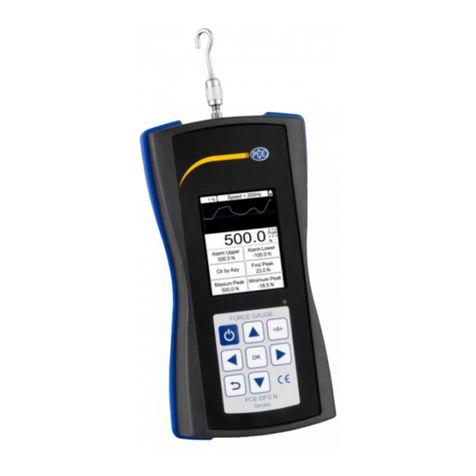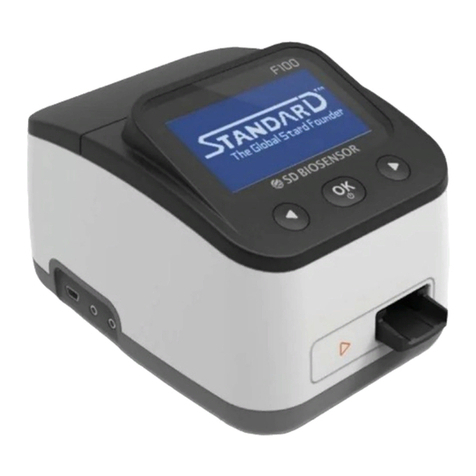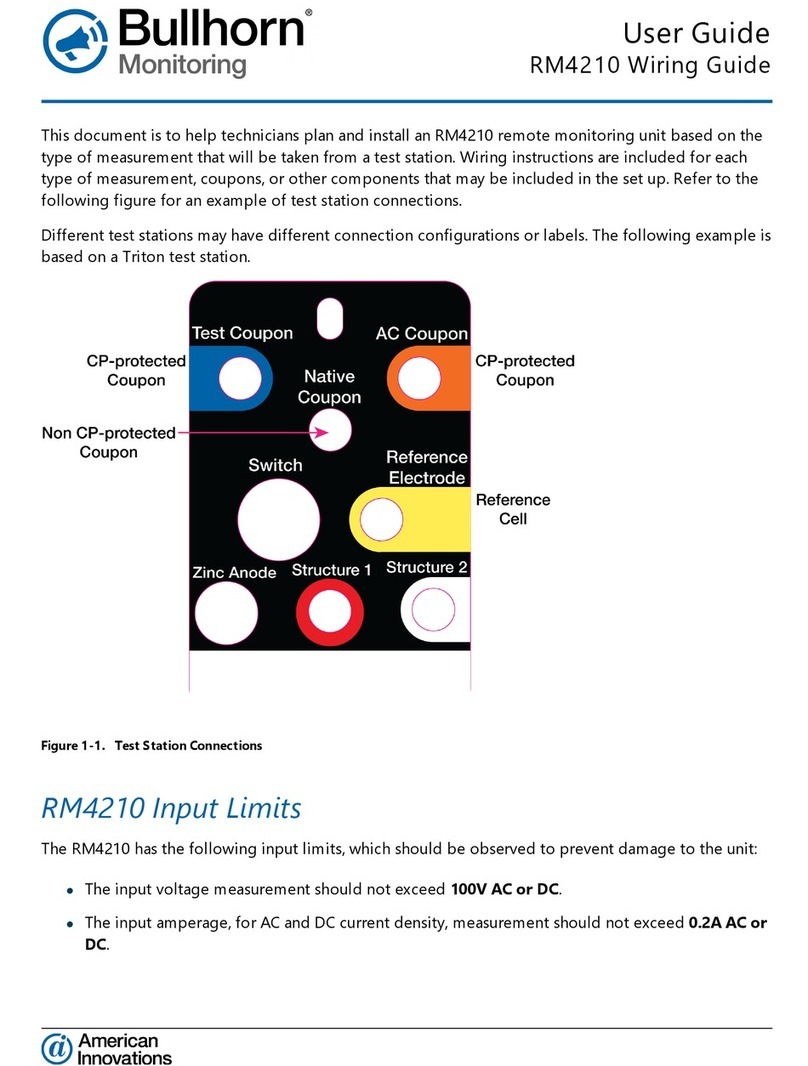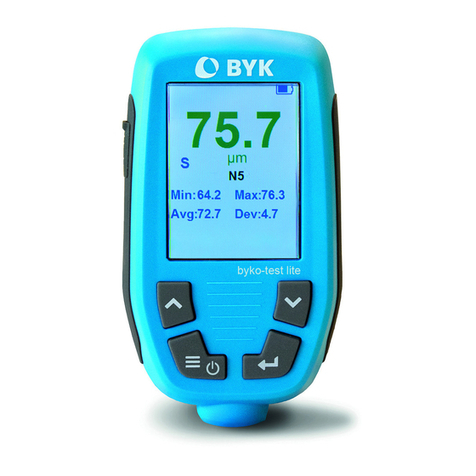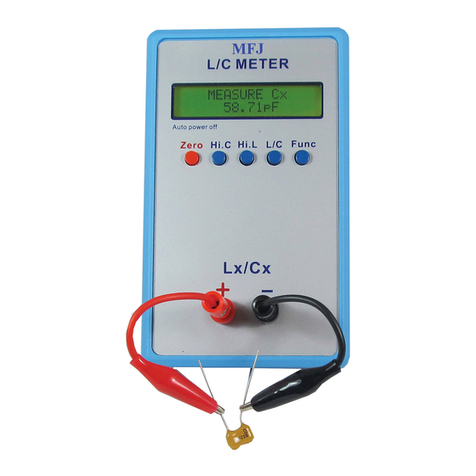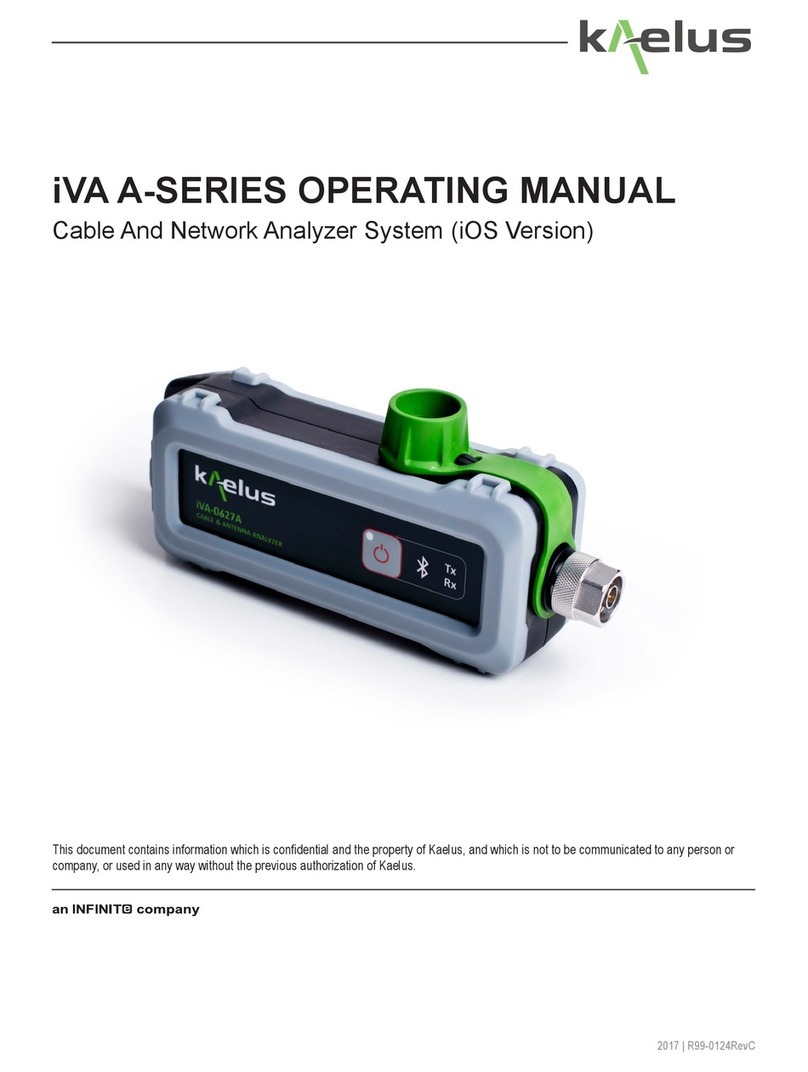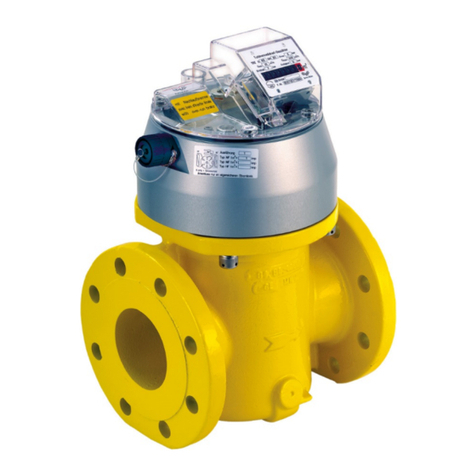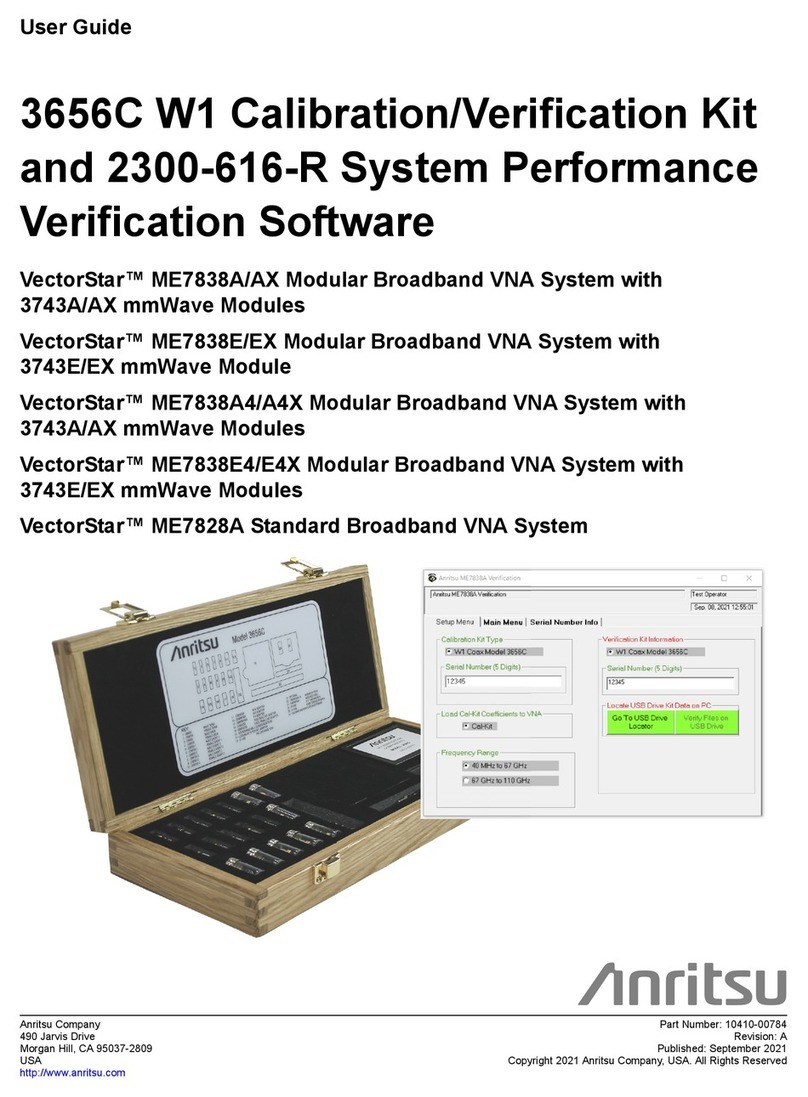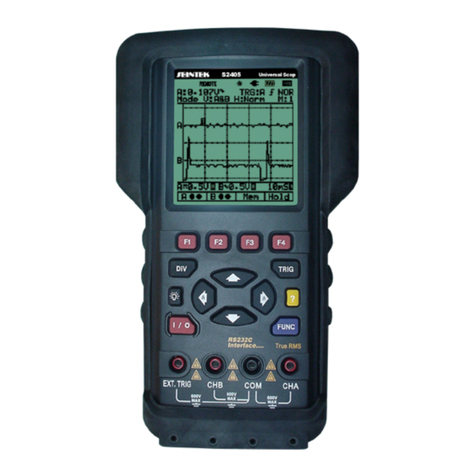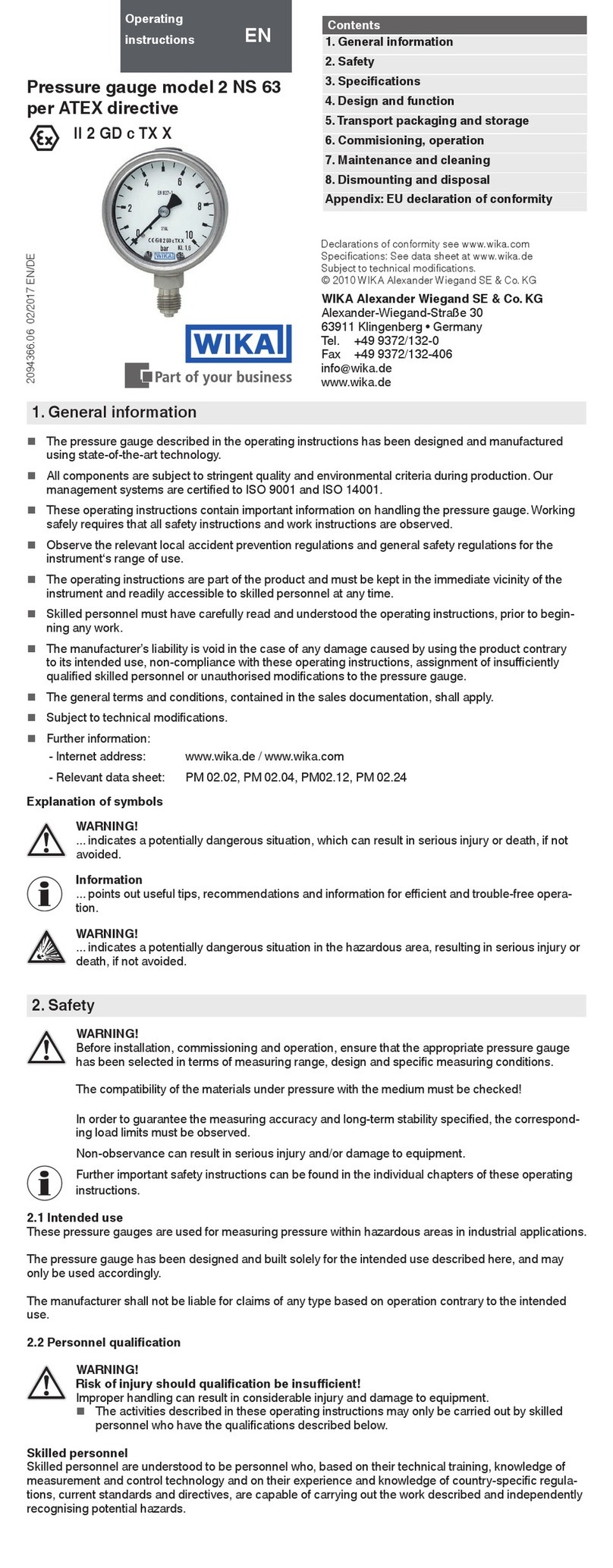Shimaden SR186A Series User manual

Series SR186A Hybrid Recorder
Instruction Manual

i
PREFACE
Congratulations on your purchase of Hybrid Recorder (Type:SR186A )
• Read this instruction manual carefully to ensure correct installation, operation and preparation.
Incorrect handling may lead to accident or injury.
• Specifications of this unit is subject to change without prior notice for improvement.
•Modification of this unit without permission is strictly prohibited.
Shimaden will not bear any responsibility for a trouble caused by such a modification.
• This instruction manual should be kept by the person who is actually using the unit.
• After reading the manual, be sure to keep it at a place easy to access.
• This instruction manual should be delivered to the end user without fail.

ii
Wrong handling may cause a dangerous situation, in which there
is a risk of death or heavy injury.
Wrong handling may invite a dangerous situation, in which there
is a possibility of medium level trouble or slight injury or only
physical damage is predictable.
Items which must not be done are noted.
First of all, read this "Caution on safety" before using the unit.
•The cautionary descriptions listed here contain important information about safety, so they should
always be observed.
Those safety precautions are ranked to 2 levels, DANGER and CAUTION.
CAUTION ON SAFETY
Caution on Installation
•This unit is not an explosion-proof type. Do not use it in a
place with explosive gases to prevent explosion, fire or other
serious accident.
•For installation, select a place observing the operating condi-
tions noted in the instruction manual.
Installation at an unsuited place may cause fall, trouble or
malfunction.
•The unit must be installed correctly as shown in the instruc-
tion manual. Incorrect installation may cause fall, trouble or
malfunction.
•During installation work, keep the inside of the unit free from
entry of cable chips or other foreign objects as it may cause
fire, trouble or malfunction.
PROHIBITION
This unit is a component device used for instrumentation. It is
mounted on a panel or in a rack.
•The unit conforms to IEC1010-1 (1990) Safety Standards, and
is designed for protection class I, overvoltage Category II and
pollution degree 2, except the alarm output terminal (overvolt-
age category I).
•EMC conforms to EN50081-1 (1992) and EN50082-1 (1992),
(both used for housing areas), except that the noise level of the
power terminal is rated for Class A (used for commercial and
industrial areas).
•Input signals and communication interface should be of SELV
(safety separated from hazardous voltage).
DANGER
CAUTION
DANGER
CAUTION
CAUTION

iii
Caution of Wiring
Caution on Maintenance
• Wiring work must be performed as specified.
If the unit is not earthed, it would result in electric shocks or
malfunction.
• Be sure to connect power source that matches the rating.
Connection of incorrect rating of power source may lead to fire.
• Before starting wiring work, be sure to turn OFF the main power
to prevent electric shocks.
•
Wiring materials to be used must meet the rating. Use of materials
which do not withstand the rating may cause a fire accident.
• When disposing of the recording head, put it in a vinyl bag and
seal it to prevent the diffusion of ink. It should be handled as an
imcombustible object when disposing of it.
• Ink is harmful to human body. Observe the following emer-
gency treatments.
- When ink gets in eyes, wash out for at least 5 minutes imme-
diately with much clean water, and ask your doctor for treat-
ment at once.
- When ink gets on skin, wash out and clean skins with soap
and water.
- When ink is breathed in, move to a clean place immediately.
If necessary, ask your doctor for treatment at once.
• Do not touch the connector at the rear of the carriage mounting
the recording head to avoid the risk of electric shocks.
DANGER
DANGER
• If the fault or anomaly of the device may cause serious acci-
dent or troubles to other devices, externally install appropri-
ate protective circuit to avoid accidents.
• When fuse is blown out, check and remove the cause of it,
and replace it with new one specified in the instruction manual.
Do not use any other fuse or short it, as it may cause electric
shocks or fire.
Caution on Use
DANGER

iv
ONTENTS
PREFACE ...................................................................................................................................i
CAUTION ON SAFETY.............................................................................................................. ii
1. INTRODUCTION ............................................................................................................. 1-1
1.1 About the microjet recorder ................................................................................................. 1-1
1.2 Product check ....................................................................................................................... 1-1
1.3 Check on type and specification .......................................................................................... 1-2
2. NAMES AND FUNCTIONS OF PARTS ........................................................................... 2-1
3. MOUNTING METHOD..................................................................................................... 3-1
3.1 Mounting location ................................................................................................................ 3-1
3.2 External dimensions and panel cut out dimensions ............................................................. 3-1
3.3 Method of mounting onto panel........................................................................................... 3-2
4. WIRING ........................................................................................................................... 4-1
4.1 Before doing the wiring ....................................................................................................... 4-1
4.2 Connection of wires to terminals ......................................................................................... 4-1
5. SET-UP ............................................................................................................................ 5-1
5.1 Loading chart paper ............................................................................................................. 5-1
5.2 Recording head installation (replacement) .......................................................................... 5-4
5.3 Changing the type of input signals....................................................................................... 5-9
6. OPERATION AND ACTIONS .......................................................................................... 6-1
6.1 Before running the equipment: ............................................................................................ 6-1
6.2 Power switch-on and states .................................................................................................. 6-2
6.3 Test pattern print-out ............................................................................................................ 6-3
6.4 Actions during operation...................................................................................................... 6-3
6.5 Displays and print-outs on detection (cancellation) of alarms............................................. 6-5
6.6 Displays and print-outs on occurrence of burnt-out............................................................. 6-5
6.7 Over-range, under-range display and abnormal input display ............................................. 6-6
6.8 Display and record when chart paper runs out..................................................................... 6-6
6.9 Display and record when the recording head ink is low ...................................................... 6-6
6.10 Display when data backup batteries need to be replaced..................................................... 6-7
6.11 Display of fault in recording head carriage.......................................................................... 6-7
6.12 Order of priority of state displays ........................................................................................ 6-7
7. SETTING AND CHECKING PARAMETERS ................................................................... 7-1
7.1 Setting and checking ............................................................................................................ 7-1
7.2 Outline of procedure for setting parameters ........................................................................ 7-3
7.3 Pass code setting .................................................................................................................. 7-4
7.4 Setting the chart speed ......................................................................................................... 7-5
7.5 Setting alarms....................................................................................................................... 7-7
Chapter 3, 4 and chapter 8 should be observed for installation and mainte-
nance of the unit. So, it must be performed by qualified engineers.
CAUTION

v
7.6 Setting the recording mode .................................................................................................. 7-8
7.7 Setting record ranges.......................................................................................................... 7-12
7.8 Setting kind of input, skip, unit, filter, scaling, subtraction ............................................... 7-13
7.9 Setting Tag Nos. ................................................................................................................. 7-19
7.10 Message print specification................................................................................................ 7-20
7.11 List print-out specification ................................................................................................. 7-23
7.12 Daily report specification ................................................................................................... 7-24
7.13 Specifying totalize function ............................................................................................... 7-26
7.14 Transmission specification (option) ................................................................................... 7-27
7.15 Setting the time .................................................................................................................. 7-29
7.16 Clearing the ink monitor .................................................................................................... 7-30
7.17 Turning the chart illumination lamp on/off (option) .......................................................... 7-31
8. MAINTENANCE - INSPECTION ..................................................................................... 8-1
9. APPLICATION FUNCTIONS ........................................................................................... 9-1
9.1 Adjustment of backlash........................................................................................................ 9-1
9.2 Zero/span adjustment for analog trend recording position .................................................. 9-2
9.3 Setting of alarm latch and integrated value print-out........................................................... 9-3
9.4 Setting of PV shift................................................................................................................ 9-4
9.5 User definable unit ............................................................................................................... 9-5
9.6 Setting of record error external output ................................................................................. 9-6
9.7 Calibration of measured value ............................................................................................. 9-7
9.8 Change of record color......................................................................................................... 9-8
9.9 Language selection............................................................................................................... 9-8
10. TROUBLESHOOTING................................................................................................... 10-1
11. EXAMPLES OF RECORDS AND PRINT-OUTS ........................................................... 11-1
11.1 Periodic print-outs, scale print-outs ................................................................................... 11-1
11.2 Digital print-out (instantaneous values) ............................................................................. 11-2
11.3 Parameter list print-out....................................................................................................... 11-3
11.4 Test pattern ......................................................................................................................... 11-3
11.5 Scale print-outs .................................................................................................................. 11-3
11.6 Daily report print-out ......................................................................................................... 11-4
11.7 Data sum list print-out ....................................................................................................... 11-5
11.8 Message print (manual print) ............................................................................................. 11-5
11.9 Logging .............................................................................................................................. 11-6
11.10 Alarm print-outs ................................................................................................................. 11-6
11.11 Burn-out print-out .............................................................................................................. 11-6
11.12 Ink dry-up warning print-out.............................................................................................. 11-6
11.13 Record start mark ............................................................................................................... 11-7
11.14 Chart speed change mark ................................................................................................... 11-7
11.15 Auto-range change mark .................................................................................................... 11-7
12. SPECIFICATION............................................................................................................ 12-1

1 - 1
1.1 About the Hybrid recorder
(1) This recorder is a multirange input recorder 180mm wide which can record up to a maximum of 12
points using thermocouler/resistance bulb and DC voltage input signals.
(2) It effects high-speed recording and gives clear analog trend records and digital print-outs in 6
colors.
(3) The analog trend records can be given as continuous record type or as intermittent (dot) records.
(See Section 1.3, Format specification.)
(4) As well as providing records of measurement values, the standard unit has a wide range of print-
out functions comprising, e.g., the print-out of dates, chart speed, measurement ranges, Tag Nos.,
daily reports and integrated totals.
(5) Operation of the equipment is simple thanks to an easy-view display section which permits key-in
of various items of set data.
1.2 Product check
Check on accessories.
The unit comes with the accessories shown in Fig. 1-1. Please check that they are all there.
1. INTRODUCTION
Instruction Manual
(4) Instruction manual
(5) Fuse
(3) Recording paper
FujiElectricCo.,Ltd.
(1) Panel fitting (2) Recording head
(with cloth for blotting ink)
(1) Panel fitting .................................................................................................2
(2) Recording head (with cloth for blotting ink)...............................................1
(3) Recording paper ..........................................................................................1 pack
(The format of standard recording paper is SRX00BL-1000R.)
(4) Instruction manual .......................................................................................1
(5) Fuse (250V/1A AC) ....................................................................................1
Note: Item 5 is appended on the back side of the main unit.
Fig. 1-1 Accessories
Before using the recorder, read this manual carefully as it describes its installation, operation,
maintenance, etc.

1 - 2
1.3 Check on type and specification
The data plates note the type name, etc. Please check to see that you have got a unit with the specification
you ordered. (There are data plates on the top surface of the case and in the main unit.)
• Ex-works values of input signals
Thermocouple: K 0 to 1200°C
Resistance bulbs: Pt 100 0 to 500°C
DC voltage: -5 to +5V DC
• Relations between input signal specifications
and recording channels
Ex.: If 3 thermocouple points, 6 resistance bulb
points and 3 DC voltage points are specified.
Channels 1 to 3 are thermocouple
Channels 4 to 9 are resistance bulbs.
Channels 10 to 12 are DC voltage.
Note: The "Z" in places 5, 6 and 7 indicates a non-standard specification. Please check by the
positions of the input signal type setting pins indicated in Section 5.3.
Note: After purchasing the unit, the type of input signal can be changed within the number of the
record pins (See Item 5.3).
• Supplementary supplies
Items Type Remarks
Chart paper (100 divisions) ´6 charts / box SRX00BL-1000R
Recording head ´1 SRZH1001
(PHZH1002)
Alarm output / external control unit SRZK8601
6-points alarm output / 3-points external control
Approx. 20m (6 packs / box)
1 per unit
Alarm output / external control unit SRZK8201
12-points alarm output / 3-points external control
Chart paper illumination SRZL8001 With cable connector
Shunt resistor 10W±0.1% SRZT8101 For 4~20mA or 10~50mA input
Interface unit SR7D0834C2 RS-485
ITEMS CODE SPECIFICATIONS
SERIES SR186A- Hybrid recorder, DIN 288 ´288mm
1 1 Continuous recording
2 2 Continuous recording
RECORDING 3 3 Continuous recording
SYSTEM 6 6 Continuous recording
7 6 Dot recording
8 12 Dot recording
1 Thermocouples B, R, S, K, E, J, T, N, W, L, U, PN
INPUT 2 R.T.D (Pt100)
3± 50mV, ±500mV, ±5V, ±50V DC
4~ 20mA Available with shunt resistor (option)
MENU INSTRUCTION J Japanese
E English
POWER SUPPLY 86- 85~300V AC, 50 / 60Hz
CHART PAPER ILLUMINATION 0 Without
1 With
0 Without
ALARM OUTPUT / EXTERNAL CONTROL 1 6-points alarm output / 3-points external control
2 12-points alarm output / 3-points external control
INTERFACE FUNCTION 0 Without
5 RS-485
REMARKS 0 Without
9 With (Please consult before ordering.)

2 - 1
(1) Display section
For displays such as measurement data, units and displays of various parameters and comments
display of units and data for each channel display of various parameters, comments
display of units and data for each channel
display of varous parameters, comments
(2) Recording head
This is a recording head which serves for analog trend recording and digital print-outs. As this is
not installed in the main unit at the time of delivery, please install it referring to Section 5.2.
(3) Lock screws
To change the type of input signals, remove the lock screws on the left and right, detach the main
unit and make changes inside the instrument (replace the input signal setting pins).
Note that changes in the type of thermocouple can be effected by front panel key operations.
* 'Changes in the type of input signals' means changes as indicated below.
Thermocouple Resistance bulbs
DC voltage
For details, see Section 5.3.
However, change to the thermocouple model or switching between new JIS and old JIS for resis-
tance bulb can be performed by key operation on the front face.
(4) Lever
This is a lock lever for opening and closing the recording paper holder.
(5) Fuse holder
The holder contains a 250V/1A AC power supply fuse.
2. NAMES AND FUNCTIONS OF PARTS
(1) Display section (2) Recording head
(7) Key actuation section
(5) Fuse
(6) Power supply switch (4) Lever (3) Lock screws

2 - 2
(6) Power supply switch
Used to turn on and off the power.
(7) Keying operation section
This is used for setting various parameters, making checks and running the equipment.
FEED LIST DISPLAY
SELECT ENTRY
RECORD
Name of key Function
RECORD Operation key for starting and stopping recording.
Recording starts when the key is pressed once and stops when the key is pressed again. This
key is ineffective during print-out of data or lists.
LIST This is used for effecting print-out of data (instantaneous values).
If you wish to stop the print-out partway through, press the key again.
The recording paper fast feed key.
This key is always valid.
FEED The speed is 3mm/sec during the first second that the key is held depressed and goes to
8mm/sec after the elapse of 1 second.
DISPLAY 1. This is used for changing the contents of displays. Successively pressing the key and
releasing it brings about the following 5 changeovers.
(1) Sequential display of the data of all channels.
However, there is no display for skip channels.
The data display is updated once every 3 seconds.
(2) Display only of the data of specific channels.
The data display is updated once every second.
(3) No 1 to 6 channels are display simultaneously, and data display is updated at 1 sec-
ond intervals.
(4) 7 - 12 channels are displayed simultaneously.
(This panel is not displayed when the number of recorded points is up to six.)
Data display is updated once every second.
(5) Display of the data and time.
2. This key is used for shifting from a set mode to the data display mode.
This key is ineffective during print-out of data or lists.
SELECT 1. Used for shifting from the data display mode to a set mode.
2. Is used for effecting sequential read-out of parameters during operation in a set mode.
This key is ineffective during print-out of data or lists.
ENTRY Is used to register set data.
This key is effective only during set mode operation.
Used to scroll numerical values up and down.
(up) (down) The values are scrolled up or down 1 count each time the relevant key is pressed. Holding a
key depressed for more than 0.5 seconds results in a fast up/down scroll at a rate of 5 counts/
second and holding it depressed for a further 2 seconds results in an ultra-fast scroll of 55
counts/second.
Special keying operations
Press key Used for reversing the recording paper feeding direction.
while pressing (However, continuous feed is permitted up to about 25 mm.)
the FEED key.

3 - 1
This unit is designed to be panel mounted.
3.1 Mounting location
Select the following location for mounting the unit.
(1) A place that is not subject to vibration or impact.
(2) A place where there is no corrosive gas.
(3) A place that is subject to little temperature variation and is
close to normal temperature (23°C)
(4) A place that is not struck directly by strong radiant heat.
(5) As humidity affects the ink and recording paper, select a place
that is in the range 45 to 80% RH.
(6) Mount the unit horizontally, with no tilt to the left or right.
(The forward tilt should be 0 (but the unit may be inclined 0 to
30°rearwards.)
3.2 External dimensions and panel cut out dimensions (unit: mm)
3. MOUNTING METHOD
∠ α
∠ α = 60 to 90
280
312
288
288
360MIN
281
+2
0
281
+2
0
320MIN 280
16039
18199
Transmission terminal
(option)
Alarm unit (option)
(Alarms 7 to 12) Alarm, external
control unit
(option) (Alarms 1 to 6)
Mounting
attachment 2≤t≤30
Panel
Power supply terminal
Input terminals
(inputs 7 to 12)
Input terminals
(inputs 1 to 6)
Panel cut dimensions (unit: mm) Mass: Approximately 6kg (without options)
Approximately 7kg (with all options)
Power consumption: Approximately 22VA
(100V AC without options)
Approximately 37VA
(100V AC with all options)

3 - 2
3.3 Method of mounting onto panel
• Tighten and fix the mounting screw attachments on the left and right.
• Use a panel that is 2mm or more thick.
Panel
Screw
Screw

4 - 1
4.1 Before doing the wiring
To carry out wiring, remove the unit's rear cover (Notes).
(1) For the power cable, use a 600V vinyl-insulated cable (JIS C 3307) or a cable with equal or supe-
rior performance to this.
(2) Use compensating leads for thermocouple inputs.
(3) To avoid the effects of induction noise, keep input signal leads as far away as possible (at least
30cm) from power supply lines and lines carrying heavy current. Also, wherever possible use a
shieled cable and earth one point of the shield.
(4) For wiring the terminals, use a maximum of 2 crimp style terminals.
Notes
(1) To remove the rear cover, put a finger in a cable
through-hole in the cover, gently raise the cover
and then pull outwards.
(2) After wiring up the input terminals, always re-
place the rear cover in its original position so as
to ensure proper compensation of reference con-
tacts for thermocouple inputs.
(3) We recommend the use of insulation-sleeve
solderless terminals (using M4 thread) for con-
necting wires to terminals.
4.2 Connection of wires to terminals
(1) Input terminals
➪Connect signal leads for each channel.
(2) Alarm, external control unit (option)
➪Connect the alarm signal outputs and ex-
ternal control signal inputs (for alarms 1
to 6, external controls 1 to 3).
(3) Alarm unit (option)
➪Connect the alarm signal outputs (for
alarms 7 to 12).
(4) Power supply terminal
➪Connect the power cables to AC/AC ter-
minals. Connect to a noise-free, stabi-
lized power supply.
This is an 100 to 240V AC free power supply.
(5) Ground terminal ➪ Effect type 3, Grounding (not more than 100Ω) of the G terminal.
(6) Transmission terminal (option) ➪ Connect the transmission signals.
4. WIRING
Alarm unit are of overvoltage category I.
Other signal (input, communication interface) should be SELV (safety separated from
hazardous voltage).
CAUTION
(6)
(3)
(2)
(4)(5)
(1)
(Inputs 7 to 12) (1)
(Inputs 1 to 6)

4 - 2
(1) Wiring of input terminals
(1) There are individual input terminal numbers for different channels.
(2) Make connection in accordance with the relation between number of input signals by type designa-
tion and channels (see section 1.3).
(3) If you decide to change the type of input signals after your purchase, be sure to remember to wire
up the requisite channel accordingly.
71
72
73
81
82
83
91
92
93
101
102
103
111
112
113
121
122
123
AB
b
AB
b
11
12
13
21
22
23
31
32
33
41
42
43
51
52
53
61
62
63
AB
b
AB
b
+
–
+
–
+
–
+
–
+
–
+–
+
–
+
–
Thermocouple input
Compensating
leads
11
12
13
21
22
23
DC voltage input
DC voltage input
Note: Avoid using thermocpoule inputs with
wiring parallel to other instruments.
Thermocouple
Blank Blank
Resistance
bulb Thermo-
couple DC
voltage Terminal number
Input 7
(CH7)
Input 8
(CH8)
Input 9
(CH9)
Input 10
(CH10)
Input 11
(CH11)
Input 12
(CH12)
Input 1
(CH1)
Input 2
(CH2)
Input 3
(CH3)
Input 4
(CH4)
Input 5
(CH5)
Input 6
(CH6)
Example Input terminal wiring

4 - 3
A
B
b
Example: A 10Ω±0.1% shunt resistance is
used for 4 to 20mA, 10–50mA input.
31
32
33
Blank
In this case, ±500mV input range is
available. See Section 5-3.
Note: DC current input is converted into voltage by
shunt resistor (10Ω):
In 4 to 20mA DC : 40 to 200mV DC range
In 10 to 50mA DC :100 to 500mV DC range
71
72
73
81
82
83
91
92
93
101
102
103
111
112
113
121
122
123
AB
b
AB
b
11
12
13
21
22
23
31
32
33
41
42
43
51
52
53
61
62
63
AB
b
AB
b
+
–
+
–
+
–
+
–
Resistance
bulb Thermo-
couple DC
voltage Terminal number
Input 7
(CH7)
Input 8
(CH8)
Input 9
(CH9)
Input 10
(CH10)
Input 11
(CH11)
Input 12
(CH12)
Input 1
(CH1)
Input 2
(CH2)
Input 3
(CH3)
Input 4
(CH4)
Input 5
(CH5)
Input 6
(CH6)
Example Input terminal wiring
Resistance bulb input DC current input
+
–
+–
A
Resistance bulb
B
bDC current input
Shunt
resistance

4 - 4
(2) Alarm output/remote control unit (option)
About alarm outputs :
(1) Alarms can be set at 4 points in each channel and alarm outputs are provided as an option for up to
a maximum of 12 points.
(2) When an alarm is detected, the relevant terminals are shorted.
Relay contact capacity 240V/3A AC, 30V/3A DC (resistive load), 1a contact
14 24
15 25
16 26
17 27
18 28
19 29
31 41
32 42
33 43
34 44
35 45
36 46
Alarm 1
Alarm 2
Alarm 3
Alarm 4
Alarm 5
Alarm 6
Alarm 7
Alarm 8
Alarm 9
Alarm 10
Alarm 11
Alarm 12
Note: If lamps are used on the outside, insert a resistor to prevent surge current. Also, if relays or
solenoids are used, insert elements for contact protection (diodes, surge killers, etc.)
About remote control inputs
(1) This performs the functions 'Recording operation start/stop', 'Two-stage changeover of recording
paper speed' and 'Data (instantaneous value) print-out' in response to contact signals from outside
the instrument.
(2) There are separate wiring terminals for the different functions.
(DI1) Record start .................. Recording starts when the contact is closed and
stops when the contact is open.
(DI2) Chart speed change ...... The chart speed is the remote mode speed when
the contact is closed and the normal operation
speed when the contact is open.
(DI3) Data print...................... Print-out starts when the contact is closed and
goes on right to the end even if the contact is
opened partway through the print-out. If you
wish to stop print-out partway through, press the
LIST key on the front panel.
Note 1: As the external control unit is not insulated, use it with interposition of an external relay.
External contact capacity 12V DC/0.05A 1a contact
Note 2: Operations effects by the external control unit and the front panel switches are as in the table
below. (A - in a box of the table indicates that no effect at all is had on the main unit operation.)
Note 3: When using the message print function or alarm latch function, the meaning of control input is
different. Refer to "7.10 List print-out setting" and "9.3 Alarm latch specification".
11 21
12 22
13 23

4 - 5
(3) Caution on connection of input signal through barrier
Thermocouple input and resistance bulb input
Perform "Calibration of measured value" with the input connected to the barrier recorder because
the barrier internal resistance is added and causes an error in the measured value.
For the calibration method, refer to Item 9.4.
RECORD
LIST
ON OFF ON OFF ON OFF
Remote control
Recording starts
(across terminals
(11) to (21))
Chart speed change
(across terminals
(12) to (22))
Data printout
(across terminals
(13) to (23))
Recording
starts
Recording
stops
Recording
starts
While
recording
is stopped
During
recording
List
printout
Remote
mode chart
speed
Normal
operation
chart speed
List
printout
starts
List
printout
starts
Recording
starts
Recording
starts
List
printout
starts
List
printout
starts
List
printout
stops
Front panel switch

5 - 1
5.1 Loading chart paper
Step 1 Riffle and loosen the recording paper so as to
prevent overlapping feed.
Step 2 Open the front flap, push the paper hold-down
roller to the right and detach it.
To replace chart paper while recording is in
progress, carry out the above after pressing
the RECORD key to stop recording.
Step 3 Raise the lever that is on the right.
This releases the lock, the paper feeder moves
downward and paper holder can be seen.
5. SET-UP

5 - 2
Step 4 With round holes (small holes) in the recording
paper located on the left-hand side, set the re-
cording paper so that its leading edge with both
corners cut off comes to this side. Then insert
the leading edge into the container with the print-
ing face located upward.
Butt the recording paper to the left-hand end and
set the recording paper in this position at this
time. Furthermore, be careful so that the recording
paper will not be located aslant. In addition, droop
the first two or three folds of the recording pa-
per into the recording paper receiver.
Step 5 Press the chart paper so that its holes engage with
the sprockets and then, without further adjust-
ment, return the paper holder to its original place.
Make sure that the chart paper does not lift up.
Note: If chart paper lifts up and contacts the re-
cording head, it can prevent ink coming
out. It can also cause improper paper feed.
Step 6 Return the paper hold-down roller to its original
position.
Check to make sure that the chart paper is straight
and that its holes are properly engaged with the
sprockets.
In order to prevent the chart paper slipping to the
left or right,
position equipment so that the pa-
per folds into the middle of the paper catcher.
Turn the power supply switch on.

5 - 3
Step 7 Press the FEED key and check that the chart
paper is fed out smoothly. (Feed out about 2 folds
of paper.)
<If the paper is not fed out smoothly, go through
the procedure from Step 2 again.>
Note 1: Selection of chart paper
The chart paper greatly affects the quality of the printed recording and it is also related to prob-
lems such as paper jamming, etc.
Please be sure to use the pure-quality chart paper specified by us.
Chart paper type:SRX00BL-1000R (100 equal divisions, no time lines)
Note 2: Use of the recorder after it has been left unused for a long time
If the recorder is left unused for a long time with chart paper still in the main unit, the paper 'packs
down' and if the recorder is used straightway there can be problems of paper jamming, etc.
If you use the equipment after it has been left unused for a long time, first press the FEED key to
feed out 2 to 3 folds of the paper.
Reference 1: Chart paper length
The chart paper is approximately 20m long. This permits about 31 days continuous print-
out at a paper feed speed of 25mm/h.
Reference 2: Chart paper end mark
The amount of chart paper remaining is indicated by digits (units : cm) on the right-hand
side of the paper. When there is only a small amount left, red letters appear on the right-
hand edge.
If the recording paper runs out completely, a recording paper end indicator displays 'Chart
end' in the display section and recording automatically stops.
Table of contents
Other Shimaden Measuring Instrument manuals
